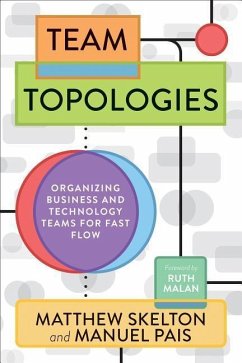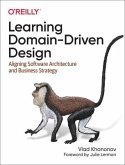Matthew Skelton, Pais, Manuel, coauthor of Team Topologies
Team Topologies
Organizing Business and Technology Teams for Fast Flow
27,99 €
inkl. MwSt.
Versandfertig in 2-4 Wochen

14 °P sammeln
Matthew Skelton, Pais, Manuel, coauthor of Team Topologies
Team Topologies
Organizing Business and Technology Teams for Fast Flow
- Broschiertes Buch
- Merkliste
- Auf die Merkliste
- Bewerten Bewerten
- Teilen
- Produkt teilen
- Produkterinnerung
- Produkterinnerung
In Team Topologies IT consultants Matthew Skelton and Manuel Pais share secrets of successful team patterns and interactions for IT through four fundamental team topologies and three interaction modes.
Andere Kunden interessierten sich auch für
![Accelerate Accelerate]() Nicole ForsgrenAccelerate18,99 €
Nicole ForsgrenAccelerate18,99 €![Das Mindset von DevOps. Accelerate Das Mindset von DevOps. Accelerate]() Nicole ForsgrenDas Mindset von DevOps. Accelerate34,90 €
Nicole ForsgrenDas Mindset von DevOps. Accelerate34,90 €![Specification by Example Specification by Example]() Gojko AdzicSpecification by Example47,99 €
Gojko AdzicSpecification by Example47,99 €![The Devops Handbook, 2nd Edition The Devops Handbook, 2nd Edition]() Gene KimThe Devops Handbook, 2nd Edition28,99 €
Gene KimThe Devops Handbook, 2nd Edition28,99 €![The Enterprise Data Catalog The Enterprise Data Catalog]() Ole Olesen-BagneuxThe Enterprise Data Catalog60,99 €
Ole Olesen-BagneuxThe Enterprise Data Catalog60,99 €![Learning Domain-Driven Design Learning Domain-Driven Design]() Vladik KhononovLearning Domain-Driven Design42,99 €
Vladik KhononovLearning Domain-Driven Design42,99 €![The Five Dysfunctions of a Team The Five Dysfunctions of a Team]() Patrick M. LencioniThe Five Dysfunctions of a Team22,99 €
Patrick M. LencioniThe Five Dysfunctions of a Team22,99 €-
-
-
-
-
-
-
-
-
In Team Topologies IT consultants Matthew Skelton and Manuel Pais share secrets of successful team patterns and interactions for IT through four fundamental team topologies and three interaction modes.
Hinweis: Dieser Artikel kann nur an eine deutsche Lieferadresse ausgeliefert werden.
Hinweis: Dieser Artikel kann nur an eine deutsche Lieferadresse ausgeliefert werden.
Produktdetails
- Produktdetails
- Verlag: IT Revolution Press
- Seitenzahl: 240
- Erscheinungstermin: 17. September 2019
- Englisch, Unbestimmt
- Abmessung: 226mm x 149mm x 17mm
- Gewicht: 390g
- ISBN-13: 9781942788812
- ISBN-10: 1942788819
- Artikelnr.: 55035833
- Herstellerkennzeichnung
- Libri GmbH
- Europaallee 1
- 36244 Bad Hersfeld
- gpsr@libri.de
- Verlag: IT Revolution Press
- Seitenzahl: 240
- Erscheinungstermin: 17. September 2019
- Englisch, Unbestimmt
- Abmessung: 226mm x 149mm x 17mm
- Gewicht: 390g
- ISBN-13: 9781942788812
- ISBN-10: 1942788819
- Artikelnr.: 55035833
- Herstellerkennzeichnung
- Libri GmbH
- Europaallee 1
- 36244 Bad Hersfeld
- gpsr@libri.de
By Matthew Skelton and Manuel Pais - Foreword by Ruth Malan
Figures & Tables
Case Studies & Industry Examples
Foreword by Ruth Malan
Preface
PART I TEAMS AS THE MEANS OF DELIVERY
Chapter 1: The Problem with Org Charts
Communication Structures of an Organization
Team Topologies: A New Way of Thinking about Teams
The Revival of Conway's Law
Cognitive Load and Bottlenecks
Summary: Rethink Team Structures, Purpose, and Interactions
Chapter 2: Conway's Law and Why It Matters
Understanding and Using Conway's Law
The Reverse Conway Maneuver
Software Architectures that Encourage Team-Scoped Flow
Organization Design Requires Technical Expertise
Restrict Unnecessary Communication
Beware: Naive Uses of Conway's Law
Summary: Conway's Law Is Critical for Efficient Team Design in Tech
Chapter 3: Team-First Thinking
Use Small, Long-Lived Teams as the Standard
Good Boundaries Minimize Cognitive Load
Design "Team APIs" and Facilitate Team Interactions
Warning: Engineering Practices Are Foundational
Summary: Limit Teams' Cognitive Load and Facilitate Team Interactions to Go
Faster
PART II TEAM TOPOLOGIES THAT WORK FOR FLOW
Chapter 4: Static Team Topologies
Team Anti-Patterns
Design for Flow of Change
DevOps and the DevOps Topologies
Successful Team Patterns
Considerations When Choosing a Topology
Use DevOps Topologies to Evolve the Organization
Summary: Adopt and Evolve Team Topologies that Match Your Current Context
Chapter 5: The Four Fundamental Team Topologies
Stream-Aligned Teams
Enabling Teams
Complicated-Subsystem Teams
Platform Teams
Avoid Team Silos in the Flow of Change
A Good Platform Is "Just Big Enough"
Convert Common Team Types to the Fundamental Team Topologies
Summary: Use Loosely Coupled, Modular Groups of Four Specific Team Types
Chapter 6: Choose Team-First Boundaries
A Team-First Approach to Software Responsibilities and Boundaries
Hidden Monoliths and Coupling
Software Boundaries or "Fracture Planes"
Real-World Example: Manufacturing
Summary: Choose Software Boundaries to Match Team Cognitive Load
PART III EVOLVING TEAM INTERACTIONS FOR INNOVATION AND RAPID DELIVERY
Chapter 7: Team Interaction Modes
Well-Defined Interactions Are Key to Effective Teams
The Three Essential Team Interaction Modes
Team Behaviors for Each Interaction Mode
Choosing Suitable Team Interaction Modes
Choosing Basic Team Organization
Choose Team Interaction Modes to Reduce Uncertainty and Enhance Flow
Summary: Three Well-Defined Team Interaction Modes
Chapter 8: Evolve Team Structures with Organizational Sensing
How Much Collaboration Is Right for Each Team Interaction?
Accelerate Learning and Adoption of New Practices
Constant Evolution of Team Topologies
Combining Teams Topologies for Greater Effectiveness
Triggers for Evolution of Team Topologies
Self Steer Design and Development
Summary: Evolving Team Topologies
Conclusion: The Next-Generation Digital Operating Model
Four Team Types and Three Interaction Modes
Team-First Thinking: Cognitive Load, Team API, Team-Sized Architecture
Strategic Application of Conway's Law
Evolve Organization Design for Adaptability and Sensing
Team Topologies Alone Are Not Sufficient for IT Effectiveness
Next Steps: How to Get Started with Team Topologies
Glossary
Recommended Reading
References
Notes
Index
Acknowledgments
About the Authors
Case Studies & Industry Examples
Foreword by Ruth Malan
Preface
PART I TEAMS AS THE MEANS OF DELIVERY
Chapter 1: The Problem with Org Charts
Communication Structures of an Organization
Team Topologies: A New Way of Thinking about Teams
The Revival of Conway's Law
Cognitive Load and Bottlenecks
Summary: Rethink Team Structures, Purpose, and Interactions
Chapter 2: Conway's Law and Why It Matters
Understanding and Using Conway's Law
The Reverse Conway Maneuver
Software Architectures that Encourage Team-Scoped Flow
Organization Design Requires Technical Expertise
Restrict Unnecessary Communication
Beware: Naive Uses of Conway's Law
Summary: Conway's Law Is Critical for Efficient Team Design in Tech
Chapter 3: Team-First Thinking
Use Small, Long-Lived Teams as the Standard
Good Boundaries Minimize Cognitive Load
Design "Team APIs" and Facilitate Team Interactions
Warning: Engineering Practices Are Foundational
Summary: Limit Teams' Cognitive Load and Facilitate Team Interactions to Go
Faster
PART II TEAM TOPOLOGIES THAT WORK FOR FLOW
Chapter 4: Static Team Topologies
Team Anti-Patterns
Design for Flow of Change
DevOps and the DevOps Topologies
Successful Team Patterns
Considerations When Choosing a Topology
Use DevOps Topologies to Evolve the Organization
Summary: Adopt and Evolve Team Topologies that Match Your Current Context
Chapter 5: The Four Fundamental Team Topologies
Stream-Aligned Teams
Enabling Teams
Complicated-Subsystem Teams
Platform Teams
Avoid Team Silos in the Flow of Change
A Good Platform Is "Just Big Enough"
Convert Common Team Types to the Fundamental Team Topologies
Summary: Use Loosely Coupled, Modular Groups of Four Specific Team Types
Chapter 6: Choose Team-First Boundaries
A Team-First Approach to Software Responsibilities and Boundaries
Hidden Monoliths and Coupling
Software Boundaries or "Fracture Planes"
Real-World Example: Manufacturing
Summary: Choose Software Boundaries to Match Team Cognitive Load
PART III EVOLVING TEAM INTERACTIONS FOR INNOVATION AND RAPID DELIVERY
Chapter 7: Team Interaction Modes
Well-Defined Interactions Are Key to Effective Teams
The Three Essential Team Interaction Modes
Team Behaviors for Each Interaction Mode
Choosing Suitable Team Interaction Modes
Choosing Basic Team Organization
Choose Team Interaction Modes to Reduce Uncertainty and Enhance Flow
Summary: Three Well-Defined Team Interaction Modes
Chapter 8: Evolve Team Structures with Organizational Sensing
How Much Collaboration Is Right for Each Team Interaction?
Accelerate Learning and Adoption of New Practices
Constant Evolution of Team Topologies
Combining Teams Topologies for Greater Effectiveness
Triggers for Evolution of Team Topologies
Self Steer Design and Development
Summary: Evolving Team Topologies
Conclusion: The Next-Generation Digital Operating Model
Four Team Types and Three Interaction Modes
Team-First Thinking: Cognitive Load, Team API, Team-Sized Architecture
Strategic Application of Conway's Law
Evolve Organization Design for Adaptability and Sensing
Team Topologies Alone Are Not Sufficient for IT Effectiveness
Next Steps: How to Get Started with Team Topologies
Glossary
Recommended Reading
References
Notes
Index
Acknowledgments
About the Authors
Figures & Tables
Case Studies & Industry Examples
Foreword by Ruth Malan
Preface
PART I TEAMS AS THE MEANS OF DELIVERY
Chapter 1: The Problem with Org Charts
Communication Structures of an Organization
Team Topologies: A New Way of Thinking about Teams
The Revival of Conway's Law
Cognitive Load and Bottlenecks
Summary: Rethink Team Structures, Purpose, and Interactions
Chapter 2: Conway's Law and Why It Matters
Understanding and Using Conway's Law
The Reverse Conway Maneuver
Software Architectures that Encourage Team-Scoped Flow
Organization Design Requires Technical Expertise
Restrict Unnecessary Communication
Beware: Naive Uses of Conway's Law
Summary: Conway's Law Is Critical for Efficient Team Design in Tech
Chapter 3: Team-First Thinking
Use Small, Long-Lived Teams as the Standard
Good Boundaries Minimize Cognitive Load
Design "Team APIs" and Facilitate Team Interactions
Warning: Engineering Practices Are Foundational
Summary: Limit Teams' Cognitive Load and Facilitate Team Interactions to Go
Faster
PART II TEAM TOPOLOGIES THAT WORK FOR FLOW
Chapter 4: Static Team Topologies
Team Anti-Patterns
Design for Flow of Change
DevOps and the DevOps Topologies
Successful Team Patterns
Considerations When Choosing a Topology
Use DevOps Topologies to Evolve the Organization
Summary: Adopt and Evolve Team Topologies that Match Your Current Context
Chapter 5: The Four Fundamental Team Topologies
Stream-Aligned Teams
Enabling Teams
Complicated-Subsystem Teams
Platform Teams
Avoid Team Silos in the Flow of Change
A Good Platform Is "Just Big Enough"
Convert Common Team Types to the Fundamental Team Topologies
Summary: Use Loosely Coupled, Modular Groups of Four Specific Team Types
Chapter 6: Choose Team-First Boundaries
A Team-First Approach to Software Responsibilities and Boundaries
Hidden Monoliths and Coupling
Software Boundaries or "Fracture Planes"
Real-World Example: Manufacturing
Summary: Choose Software Boundaries to Match Team Cognitive Load
PART III EVOLVING TEAM INTERACTIONS FOR INNOVATION AND RAPID DELIVERY
Chapter 7: Team Interaction Modes
Well-Defined Interactions Are Key to Effective Teams
The Three Essential Team Interaction Modes
Team Behaviors for Each Interaction Mode
Choosing Suitable Team Interaction Modes
Choosing Basic Team Organization
Choose Team Interaction Modes to Reduce Uncertainty and Enhance Flow
Summary: Three Well-Defined Team Interaction Modes
Chapter 8: Evolve Team Structures with Organizational Sensing
How Much Collaboration Is Right for Each Team Interaction?
Accelerate Learning and Adoption of New Practices
Constant Evolution of Team Topologies
Combining Teams Topologies for Greater Effectiveness
Triggers for Evolution of Team Topologies
Self Steer Design and Development
Summary: Evolving Team Topologies
Conclusion: The Next-Generation Digital Operating Model
Four Team Types and Three Interaction Modes
Team-First Thinking: Cognitive Load, Team API, Team-Sized Architecture
Strategic Application of Conway's Law
Evolve Organization Design for Adaptability and Sensing
Team Topologies Alone Are Not Sufficient for IT Effectiveness
Next Steps: How to Get Started with Team Topologies
Glossary
Recommended Reading
References
Notes
Index
Acknowledgments
About the Authors
Case Studies & Industry Examples
Foreword by Ruth Malan
Preface
PART I TEAMS AS THE MEANS OF DELIVERY
Chapter 1: The Problem with Org Charts
Communication Structures of an Organization
Team Topologies: A New Way of Thinking about Teams
The Revival of Conway's Law
Cognitive Load and Bottlenecks
Summary: Rethink Team Structures, Purpose, and Interactions
Chapter 2: Conway's Law and Why It Matters
Understanding and Using Conway's Law
The Reverse Conway Maneuver
Software Architectures that Encourage Team-Scoped Flow
Organization Design Requires Technical Expertise
Restrict Unnecessary Communication
Beware: Naive Uses of Conway's Law
Summary: Conway's Law Is Critical for Efficient Team Design in Tech
Chapter 3: Team-First Thinking
Use Small, Long-Lived Teams as the Standard
Good Boundaries Minimize Cognitive Load
Design "Team APIs" and Facilitate Team Interactions
Warning: Engineering Practices Are Foundational
Summary: Limit Teams' Cognitive Load and Facilitate Team Interactions to Go
Faster
PART II TEAM TOPOLOGIES THAT WORK FOR FLOW
Chapter 4: Static Team Topologies
Team Anti-Patterns
Design for Flow of Change
DevOps and the DevOps Topologies
Successful Team Patterns
Considerations When Choosing a Topology
Use DevOps Topologies to Evolve the Organization
Summary: Adopt and Evolve Team Topologies that Match Your Current Context
Chapter 5: The Four Fundamental Team Topologies
Stream-Aligned Teams
Enabling Teams
Complicated-Subsystem Teams
Platform Teams
Avoid Team Silos in the Flow of Change
A Good Platform Is "Just Big Enough"
Convert Common Team Types to the Fundamental Team Topologies
Summary: Use Loosely Coupled, Modular Groups of Four Specific Team Types
Chapter 6: Choose Team-First Boundaries
A Team-First Approach to Software Responsibilities and Boundaries
Hidden Monoliths and Coupling
Software Boundaries or "Fracture Planes"
Real-World Example: Manufacturing
Summary: Choose Software Boundaries to Match Team Cognitive Load
PART III EVOLVING TEAM INTERACTIONS FOR INNOVATION AND RAPID DELIVERY
Chapter 7: Team Interaction Modes
Well-Defined Interactions Are Key to Effective Teams
The Three Essential Team Interaction Modes
Team Behaviors for Each Interaction Mode
Choosing Suitable Team Interaction Modes
Choosing Basic Team Organization
Choose Team Interaction Modes to Reduce Uncertainty and Enhance Flow
Summary: Three Well-Defined Team Interaction Modes
Chapter 8: Evolve Team Structures with Organizational Sensing
How Much Collaboration Is Right for Each Team Interaction?
Accelerate Learning and Adoption of New Practices
Constant Evolution of Team Topologies
Combining Teams Topologies for Greater Effectiveness
Triggers for Evolution of Team Topologies
Self Steer Design and Development
Summary: Evolving Team Topologies
Conclusion: The Next-Generation Digital Operating Model
Four Team Types and Three Interaction Modes
Team-First Thinking: Cognitive Load, Team API, Team-Sized Architecture
Strategic Application of Conway's Law
Evolve Organization Design for Adaptability and Sensing
Team Topologies Alone Are Not Sufficient for IT Effectiveness
Next Steps: How to Get Started with Team Topologies
Glossary
Recommended Reading
References
Notes
Index
Acknowledgments
About the Authors







